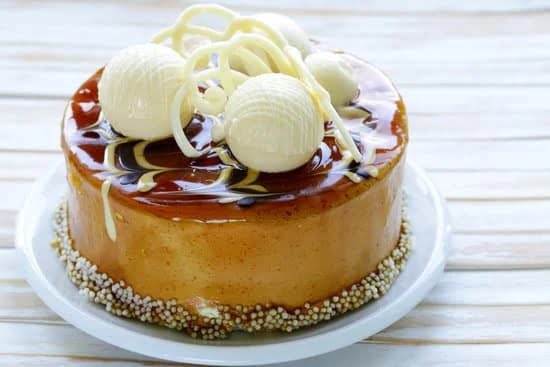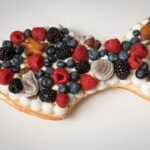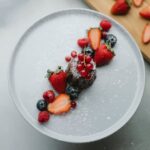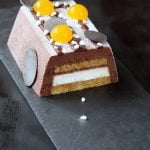A beautifully decorated vanilla cake is a sight to behold and a treat that satisfies both the eyes and the taste buds. Vanilla cake has long been a beloved dessert, celebrated for its simplicity and versatility. Whether it’s adorned with delicate flowers for a wedding or adorned with colorful sprinkles for a birthday celebration, decorating a vanilla cake allows for endless creativity and personalization.
Vanilla cake holds a special place in culinary history, with roots tracing back to ancient times. Over the centuries, this classic dessert has evolved and adapted to various cultures and palates, becoming a staple in celebrations around the world. Its timeless appeal lies in its subtle yet unmistakable flavor, which pairs perfectly with an array of decorations.
The beauty of decorating vanilla cake lies in its versatility. No matter the occasion or theme, there are countless ways to make a vanilla cake come alive. From elegant wedding cakes draped in fondant to whimsical birthday creations adorned with edible flowers or playful figures, the possibilities are only limited by one’s imagination. Each decoration adds not only visual appeal but also enhances the overall experience of indulging in a slice of moist and tender vanilla cake.
In this blog post, we will delve into the art of decorating vanilla cake, exploring everything from its intriguing history to essential ingredients for creating an exceptional base. We will discover various decoration techniques used by professionals, as well as insider tips on achieving picture-perfect results at home.
Get inspired by our showcase of decorated vanilla cakes from around the world and follow our step-by-step guide to create your own masterpiece. So grab your apron and let’s embark on an exciting journey into the enchanting world of decorated vanilla cake.
History of Vanilla Cake
Vanilla cake has a rich history that dates back to ancient times. The origins of this beloved dessert can be traced back to the Totonac people of Mexico, who were the first to cultivate vanilla beans. They believed that the vanilla plant was a divine gift, and they used it to flavor their food and drinks.
The Totonacs discovered that by pollinating the vanilla flowers by hand, they could produce larger and more flavorful beans. They also learned how to cure and dry the beans, which enhanced their fragrance and taste. The Aztecs later adopted this practice, using vanilla in their royal feasts and chocolate beverages.
It wasn’t until the 16th century when Spanish conquistadors introduced vanilla to Europe that its popularity spread across the world. Initially, it was mainly used as a fragrance rather than a flavoring agent. However, in the early 18th century, French chef Marie-Antoine Carême began incorporating vanilla into his pastries and desserts, including cakes.
Carême’s innovative use of vanilla in desserts revolutionized baking, making vanilla-flavored cakes a staple in French cuisine. From there, vanilla cake quickly gained popularity throughout Europe and eventually made its way across the ocean to North America.
Today, vanilla cake is one of the most beloved desserts worldwide. Its simple yet elegant flavor has stood the test of time and continues to be a favorite for all occasions. Whether it’s enjoyed on its own or dressed up with elaborate decorations, this classic dessert continues to bring joy and satisfaction to those who indulge in its timeless allure.
| Year | Significant Event |
|---|---|
| 16th century | Spanish conquistadors introduce vanilla to Europe |
| 18th century | French chef Marie-Antoine Carême incorporates vanilla into his desserts |
| Present day | Vanilla cake remains a popular dessert worldwide |
The Versatility of Vanilla Cake
Vanilla cake is not only delicious, but it is also incredibly versatile. One of the reasons why vanilla cake is so popular is because it can be adapted to fit various occasions and themes. Whether it’s a wedding, a birthday, or a holiday celebration, vanilla cake can be decorated in countless ways to suit the event. From simple and elegant designs to elaborate and intricate masterpieces, the possibilities are endless when it comes to decorating vanilla cake.
For weddings, vanilla cake can be transformed into a sophisticated centerpiece with delicate floral decorations made from fondant or edible flowers. The white color of the cake provides a blank canvas for any design or theme, making it easy to match the decor of the wedding. The simplicity of vanilla cake also allows for creative touches such as gold leaf accents or intricate piping that adds an elegant touch to the overall look.
Birthdays call for more playful and whimsical decorations. Vanilla cake can be turned into a colorful masterpiece with different layers of vibrant frosting and sprinkle toppings. For children’s birthdays, vanilla cakes decorated with their favorite cartoon characters or toys can bring joy to their special day. The versatility of vanilla cake allows for creativity in creating themed cakes that reflect a person’s hobbies, interests, or passions.
During holidays like Christmas or Easter, vanilla cakes can be adorned with festive decorations such as snowflakes made from royal icing or sugar flowers representing blooming spring. And let’s not forget about Halloween. Vanilla cakes have been transformed into spooky creations with ghost-shaped meringues or fondant pumpkins.
Overall, the versatility of vanilla cake is truly remarkable. It offers endless possibilities for creating unique and personalized designs that cater to any occasion or theme. Whether you’re a professional baker looking to showcase your skills or an amateur decorator wanting to try your hand at something new, decorating vanilla cake provides ample opportunities for creativity and artistic expression.
| Type of Event | Decoration Examples |
|---|---|
| Wedding | Fondant floral decorations, gold leaf accents, intricate piping |
| Birthday | Vibrant frosting layers, sprinkle toppings, themed decorations (cartoon characters, toys) |
| Holidays | Snowflakes made from royal icing (Christmas), sugar flowers (Easter), ghost-shaped meringues or fondant pumpkins (Halloween) |
Essential Ingredients for a Perfect Vanilla Cake
Creating a perfect vanilla cake starts with using the right ingredients. Each component plays a crucial role in achieving that moist and flavorful cake we all crave. Here are the essential ingredients you need to make a delicious vanilla cake.
- High-Quality Vanilla Extract: The star ingredient in any vanilla cake is, of course, the vanilla extract. Using high-quality vanilla extract can make a significant difference in the flavor of your cake. Look for pure vanilla extract rather than imitation ones, as the natural essence of pure vanilla will give your cake a rich and authentic taste.
- Fresh Eggs: Eggs act as both binders and leavening agents in baking, giving structure and lift to your cakes. It’s crucial to use fresh eggs at room temperature to ensure they blend well into the batter and contribute to a light and fluffy texture.
- Butter and Sugar: To create a tender crumb and add moisture to your vanilla cake, it’s important to use the right balance of butter and sugar. You’ll want unsalted butter at room temperature for easier creaming with the sugar. The sugar not only adds sweetness but also contributes to the texture of the cake, creating an airy and light end product.
- All-Purpose Flour: All-purpose flour is typically used in most baking recipes, including vanilla cakes. It strikes a balance between protein content (for structure) and starch content (for tenderness). Make sure to measure your flour accurately using either weighing scales or spooning it into measuring cups then leveling it off with a straight edge.
- Baking Powder: Baking powder is responsible for giving your vanilla cake its rise during baking by releasing carbon dioxide gas when exposed to heat or moisture. Be sure your baking powder is fresh so that it can fully activate and create that soft, lofty crumb we love.
Remember, while these are key ingredients for a perfect vanilla cake, it’s also essential to measure accurately and follow the recipe instructions carefully. Using high-quality ingredients and paying attention to detail will help you achieve a delicious vanilla cake that can be beautifully decorated to suit any occasion.
Top Decoration Techniques for Vanilla Cake
When it comes to decorating a vanilla cake, there are countless techniques that can elevate its appearance and make it truly stand out. Whether you’re a beginner or an experienced baker, here are some top decoration techniques to consider for your next vanilla cake creation:
- Piping Designs: Piping is a versatile technique that allows you to create intricate and impressive designs on the surface of your vanilla cake. Using a piping bag fitted with various tips, you can pipe anything from delicate swirls and rosettes to bold borders and messages. Experiment with different tip sizes and shapes to achieve different effects.
- Fondant Decorations: Fondant is a smooth, pliable icing that can be rolled out and draped over your vanilla cake for a flawless, professional finish. You can use fondant to cover the entire cake or cut it into shapes and designs to embellish the surface. From elegant ribbons and bows to whimsical characters and flowers, the possibilities with fondant decorations are endless.
- Edible Flowers & Fresh Fruit: Adding edible flowers or fresh fruit to your decorated vanilla cake can enhance both its visual appeal and flavor profile. Edible flowers such as pansies, violets, and marigolds can be pressed onto the frosting or scattered across the top for a natural touch. Likewise, strategically placing slices of vibrant fruits like berries or citrus can bring a burst of color and freshness.
These are just a few examples of popular decoration techniques for vanilla cakes; however, there is no limit to your creativity when it comes to decorating this beloved dessert. Feel free to mix and match these techniques or explore other methods like painting with food coloring, using stencils for precise patterns, or incorporating edible glitter for a touch of sparkle.
The key is to have fun and experiment with different ideas to create a visually stunning vanilla cake that will impress your family and friends. Next, we’ll dive into expert tips to help you achieve professional-looking results when decorating your vanilla cake.
Expert Tips for Decorating Vanilla Cake
When it comes to decorating a vanilla cake, there are some expert tips and tricks that can help take your creations to the next level. Whether you’re a beginner or have been decorating cakes for years, these insider secrets will help you achieve professional-looking results and wow your guests.
- Start with a smooth canvas: Before you begin decorating your vanilla cake, it’s important to ensure that the surface is smooth and even. This will provide a solid foundation for your decorations. To achieve a smooth canvas, use a sharp knife or cake leveler to remove any domed tops and then apply a thin layer of frosting as a crumb coat.
- Use the right tools: Having the right tools can make a world of difference when it comes to cake decorating. Invest in a good set of piping tips and bags for creating intricate designs and textures. A turntable can also be helpful in ensuring even frosting application. Additionally, having an offset spatula or bench scraper will make it easier to achieve clean lines and smooth finishes.
- Experiment with flavors and fillings: While vanilla cake is delicious on its own, adding complementary flavors and fillings can elevate your creation. Consider incorporating flavored syrups like raspberry or lemon between the layers to add moisture and depth of flavor. Fillings such as fruit preserves, chocolate ganache, or cream cheese frosting can also contribute to a more decadent experience.
- Dress up with edible embellishments: Edible embellishments are an excellent way to add visual interest and texture to your vanilla cake. Fresh flowers, berries, shaved chocolate, or edible glitter can all be used to enhance the aesthetics of your creation. Just ensure that any flowers or foliage used are safe for consumption and free from pesticides.
By following these expert tips, you’ll be well on your way to creating beautifully decorated vanilla cakes that are sure to impress. Remember to practice and experiment with different techniques and designs to develop your own unique style. Happy decorating.
Showcase of Decorated Vanilla Cake Ideas
Elegantly Simple Designs
In this section, we will showcase a selection of vanilla cakes that feature elegantly simple designs. These cakes are perfect for those who prefer a minimalist approach or desire a more understated presentation. One example is a vanilla cake with a smooth fondant finish and delicate sugar flowers scattered across the top.
The soft pastel colors and graceful arrangement of the flowers create a visually pleasing and sophisticated design. Another option is a naked vanilla cake, which features exposed layers of moist cake interspersed with layers of fluffy buttercream frosting. This rustic yet refined style showcases the natural beauty of the vanilla cake while adding an effortlessly chic touch.
Whimsical and Playful Creations
For those looking to add a touch of whimsy and playfulness to their vanilla cake, we have gathered some delightful ideas to inspire creativity. One whimsical design features a vanilla cake adorned with colorful sprinkles and confetti, creating a festive atmosphere perfect for birthdays or joyful celebrations.
Another playful option includes a vanilla cake decorated with bright buttercream swirls resembling fluffy clouds, giving the illusion of floating through the sky. These imaginative designs not only bring joy to celebratory occasions but also ignite one’s imagination and childlike wonder.
Elaborate Masterpieces
For those seeking show-stopping creations, we present some truly elaborate masterpieces that demonstrate the limitless possibilities for decorating vanilla cake. Picture a towering multi-tiered vanilla cake adorned with intricately piped lace patterns delicately cascading down each tier, creating an air of elegance fit for a fairytale wedding.
Another awe-inspiring design features handcrafted sugar sculptures depicting intricate scenes from nature like blooming flowers or enchanting woodlands, transforming the vanilla cake into an edible work of art. These elaborate masterpieces serve as testaments to both the skill and creativity required to take vanilla cake decoration to new heights.
By showcasing a selection of decorated vanilla cake ideas, we hope to inspire and ignite the readers’ own creativity. Whether one prefers elegantly simple designs, whimsical and playful creations, or elaborate masterpieces, the versatility of vanilla cake allows for endless possibilities. The key is to choose a design that resonates with the occasion and the desired aesthetic. With some imagination and practice, anyone can create a visually stunning and delicious centerpiece for their next celebration or gathering.
Step-by-Step Guide for DIY Vanilla Cake Decoration
Decorating a vanilla cake can be a fun and rewarding experience that allows you to showcase your creativity and personal style. With the right tools, materials, and techniques, you can transform a plain vanilla cake into a stunning masterpiece. In this step-by-step guide, we will walk you through the process of decorating a vanilla cake at home.
Before you begin decorating, it’s important to have all the necessary tools and materials on hand. You will need a fully baked and cooled vanilla cake, buttercream or fondant frosting, piping bags and tips, spatulas, offset spatulas for smoothing the frosting, and any additional decorations such as edible flowers or sprinkles.
Step 1: Prepare Your Vanilla Cake
First, ensure that your vanilla cake is completely cool before attempting to decorate it. If desired, level the top of the cake to create an even surface. This can be done using a serrated knife or a cake leveler.
Step 2: Apply a Crumb Coat
A crumb coat is an initial layer of frosting that helps seal in any loose crumbs and provides a smooth base for the final layer of frosting. Using an offset spatula or butter knife, apply a thin layer of frosting evenly over the entire cake.
Step 3: Frosting Techniques
Once the crumb coat is applied, you can start applying your final layer of frosting. Depending on your desired design, you may choose to use buttercream or fondant icing. Buttercream allows for more flexibility in terms of flavors and colors but may require additional effort in achieving a smooth finish. Fondant icing provides a clean and professional look but can be more challenging to work with.
For buttercream icing, fill your piping bag fitted with your desired tip (such as star or round) with frosting. Starting from the bottom edge of the cake, pipe long strokes around the sides until you reach the top. Smooth out any uneven areas using an offset spatula.
For fondant icing, roll out the fondant to an even thickness. Gently lift it and drape it over the entire cake, smoothing it out with your hands as you go. Trim away any excess fondant and use a fondant smoother or your hands to create a sleek finish.
Step 4: Decoration
Once your frosting is applied, you can add additional decorations to enhance the appearance of your cake. This can include piping intricate designs using different piping tips, applying edible flowers, creating fondant decorations, or adding fresh fruit for a pop of color. Be sure to press any decorations gently into the frosting to secure them in place.
With these step-by-step instructions, you now have the knowledge and confidence to decorate a vanilla cake at home. Remember to practice patience and have fun with your design. The possibilities are endless when it comes to decorating a vanilla cake, so let your creativity soar.
Troubleshooting Common Decoration Challenges
Uneven Frosting
One common challenge when decorating a vanilla cake is achieving an even layer of frosting. Uneven frosting can ruin the appearance of the cake and make it look unpolished. To avoid this, start by crumb coating the cake with a thin layer of frosting and letting it set in the refrigerator for about 15 minutes.
This will create a smooth base for the final layer of frosting. Use an offset spatula to apply the final layer, starting from the top and working your way down the sides in smooth strokes.
If you still notice unevenness, try using a bench scraper or a large icing smoother to level out the frosting further. Take your time and be patient during this process, as it may require some trial and error to achieve perfection.
Fondant Cracking
Fondant can be a tricky medium to work with, especially when decorating vanilla cakes that have intricate designs or shapes. One common problem that many beginners encounter is fondant cracking or breaking apart while covering the cake.
To prevent this issue, make sure your fondant is at room temperature before rolling it out. Knead it gently to improve its elasticity and flexibility. Dust your work surface with powdered sugar or cornstarch to prevent sticking. Roll out the fondant evenly and gradually cover the cake by draping it over the top first, then smoothing it down along the sides.
If you notice any cracks or tears in the fondant, use a small brush dipped in water to gently moisten the area and press it back together with your fingers. Remember not to use too much water as it can dissolve or make the fondant too sticky.
Smudged Decorations
When adding decorative elements such as piping designs or edible images onto your decorated vanilla cake, smudging can sometimes occur if you’re not careful. Smudges can happen when your frosting or decorations haven’t fully set, or if you accidentally touch them with your fingers.
To prevent smudging, it’s crucial to allow enough time for the cake and its decorations to fully dry and set before handling them. Place the cake in a cool, dry place with good air circulation, or use a fan to speed up the drying process.
If you accidentally smudge a decoration while working on the cake, don’t panic. You can gently scrape off the smudged area using a clean toothpick or small offset spatula. Smooth out any imperfections with clean hands or utensils, and then let the cake sit undisturbed until the frosting is firm again.
By following these troubleshooting tips, you’ll be better equipped to handle common decoration challenges that may arise while decorating your vanilla cake. Remember that practice makes perfect, so don’t get discouraged if things don’t turn out exactly as planned the first time around. With time and experience, you’ll become more skilled at overcoming obstacles and achieving stunning decorated vanilla cakes.
Conclusion
In conclusion, the art of decorating a vanilla cake is a delightful combination of history, creativity, and skill. Vanilla cake has withstood the test of time and continues to be a beloved dessert for countless occasions. Its versatility allows for endless possibilities in decoration, making it a canvas for bakers and decorators to showcase their artistic flair.
Throughout this article, we have explored the origins and evolution of vanilla cake, understanding how it has become an iconic dessert loved by many. We have also delved into the essential ingredients needed to create a perfect vanilla cake, emphasizing the importance of using high-quality components to ensure a delicious result.
Moreover, we have provided an in-depth guide to various decoration techniques for vanilla cake, offering insider tips and tricks from seasoned bakers and decorators. From intricate piping designs to fondant creations and natural adornments like edible flowers or fresh fruit, there are limitless ways to enhance the appearance of a vanilla cake.
We have showcased stunning examples of decorated vanilla cakes that serve as inspiration for readers to unleash their own creativity. Additionally, we have provided step-by-step instructions for DIY decorators so they can confidently embark on their own decorating journey at home.
Frequently Asked Questions
What compliments vanilla cake?
Vanilla cake is a versatile flavor that pairs well with many complementary flavors. One popular option is to enhance the vanilla flavor by adding a creamy vanilla frosting on top. The sweet and smooth icing adds another layer of richness to the cake.
Alternatively, you can also pair vanilla cake with fruits such as strawberries or raspberries. Their natural acidity balances out the sweetness of the cake and creates a delightful combination. Chocolate ganache is another great compliment to vanilla cake, as its deep and decadent flavor contrasts nicely with the lightness of the cake.
How to decorate vanilla cake at home without cream?
If you want to decorate a vanilla cake at home without using cream, there are still plenty of options available. One simple idea is to make a glaze using powdered sugar and liquid, such as water or lemon juice. This glaze can be poured over the cooled cake, creating a glossy finish and adding a touch of sweetness.
Another option is to use fruit purees or preserves as an alternative to cream-based frostings. Spread these fruity toppings evenly on top of the cake for added visual appeal and delicious taste. Additionally, you can decorate your vanilla cake by dusting it with powdered sugar, sprinkles, or even edible flowers for an elegant touch.
How do you keep a vanilla cake moist?
Keeping a vanilla cake moist requires some attention to detail during both preparation and storage. Firstly, it’s crucial not to overbake the cake, as this can result in dryness. Take care to follow the recommended baking time and perform a toothpick test near the end to ensure it isn’t undercooked but remains moist inside. Once baked, allow the cake to cool completely before transferring it to an airtight container or wrapping it tightly in plastic wrap, which helps trap moisture inside the cake while preventing it from drying out.
Adding generous amounts of oil or butter while making the batter can also help retain moisture in the finished product. Finally, consider brushing a simple syrup onto each layer before assembling your cake. A mixture of equal parts sugar and water, boiled and cooled, will add extra moisture and flavor.

Welcome to our cake decorating blog! My name is Destiny Flores, and I am the proud owner of a cake decorating business named Cake Karma. Our mission is to provide delicious, beautiful cakes for all occasions. We specialize in creating custom cakes that are tailored specifically to each customer’s individual needs and tastes.





